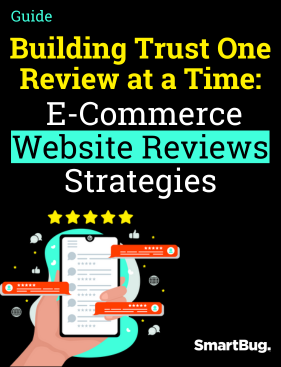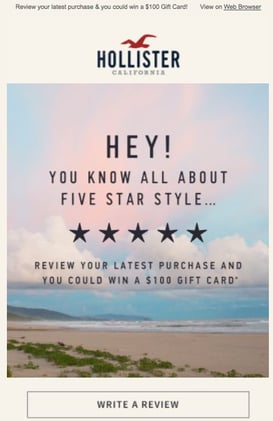
Building Trust One Review at a Time: E-Commerce Website Reviews Strategies
Reviews serve as more than just an outlet for customers to share their honest opinions on products or services they’ve received. Whether a review comes in the form of a written comment, video, or star rating, it’s an effective form of user-generated content (UGC) to build authenticity and trust from your audience—as well as a method for gathering feedback on post-purchase processes and product improvement.
In this guide, we’ll explore the importance of reviews, strategies for collecting and leveraging reviews, and what the future of e-commerce website reviews looks like.
Get a PDF of our guide on review strategies. 👇

Chapters
Why E-Commerce Reviews Matter
E-Commerce Review Strategies
Strategies in Action
The Future of Reviews
Conclusion
Why E-Commerce Reviews Matter

Simply put, reviews from real customers establish trust in your brand. Without them, prospective customers may be skeptical about whether or not your marketing content accurately reflects the quality of your products and/or services.
That’s not to say that your own generated content isn’t valuable, nor that what you offer is actually of any less quality. But when used in tandem with your brand’s messaging, e-commerce website reviews will support your claims and serve as a “stamp of approval” to anyone considering making a purchase.
💸 The ROI of Reviews
Generating reviews can directly impact sales and revenue for your brand. For many, trust can be the deciding factor in making the purchase.
Imagine this: You go to a fashion brand’s website and are considering purchasing an item of clothing. However, the item you want doesn’t have any reviews. You may be hesitant to make the purchase if you are used to relying on reviews to let you know if the item is true to size or if you should size down, if you should expect quick shipping times and an overall pleasant shopping experience, or if the quality of the item is actually as great as the company describes.
We’ve come to a point in e-commerce where reviews are the expectation. Authenticity from real customers has become crucial, and without it, prospective buyers may very well be compelled to shop elsewhere.
“The biggest gap in account audience we see is in prospect-to-customer conversion rate,” Alen Capelja, service designer manager at SmartBug Media, said. “Reviews are here to minimize that, build brand trust, and ensure the product and service quality. ROI in this case is measured in the long run—you invest in building brand trust, and as soon as you have collected enough reviews to confirm the company statement, you will start noticing prospect-to-customer conversion rates growing and customers who will explore new products easier.”
🔎 SEO Boost
Potential customers aren’t the only ones looking for authenticity; search engines are, too. With e-commerce website reviews, you’re more likely to get better retention and click rates from shoppers on your website because they’ll easily be able to scan your site and locate relevant information. This signals to search engines that your website offers what it claims to offer, improving your SEO ranking.
The more organic traffic your website receives, the better your SEO ranking will be, leading to more organic traffic and so forth. On top of this, reviews provide a regular supply of fresh content, letting search engines know you’re making frequent updates to your site (hello, even better SEO ranking and visibility).
📲 Engagement Matters
Beyond driving sales and revenue, reviews establish brand loyalty and trust with your customer base. Brands don’t always have many opportunities to connect with their customers one on one, but a review section can serve as a platform for interaction and feedback, resulting in a better relationship and sense of community. And when shoppers see these types of interactions, they may feel more compelled to purchase and leave their own reviews.
E-Commerce Review Strategies

🕓 When to Send Review Requests
Did you know that 77 percent of shoppers would leave a review if requested by a business? But when it comes to asking for reviews, it’s important to be strategic with the timing of your request. Sure, you can ask a customer to review a product right after they purchased or received a product—but would they really have the opportunity to leave an honest review?
Give your customers time to discover the true value of your product. Not only will they feel more compelled to leave a review, but they’ll actually be able to provide in-depth feedback, benefiting both potential customers and your brand.
There’s no one-size-fits-all answer to the perfect timing for sending review requests. What it comes down to is the answers to these two questions:
- What types of products does your company sell?
- How long would it take for a customer to sufficiently try the product they purchased?
If a customer buys a skincare product, for example, you may want to wait 30 days to give them time to start seeing results. In contrast, if someone buys a sports supplement to boost performance, one week would probably be plenty of time.
It’s important to find a balance between giving the customer a chance to try the product and asking soon enough that the difference the product makes in their routine will feel fresh in their mind.
🏷️ Motivate with Incentives
Offering a reward in return for a review may be just the motivation a customer needs. They might not feel compelled to leave a review unless they get something out of it—so you’ll want to provide a worthwhile incentive.
Incentives for reviews can come in a variety of forms, including:
- Discount codes
- Free gifts
- Loyalty points
- Contests or giveaways
- Being featured in an email/on social media

Keep in mind that you’ll never want to specifically request positive reviews in exchange for an incentive. For one thing, prospects can often sense insincere positivity from a mile away—leading to a lack of trust in your brand. Cliché as it may be, honesty is the best policy. You can actually leverage negative reviews to your company’s benefit ... but more on that later.
⭐ Where to Feature Positive Reviews
Of course, when you receive helpful, positive reviews, they’re great to use as a form of social proof. Reviews establish trust in your brand from customer to customer and can support the messaging in your marketing materials to drive the benefits of your products home.
Reviews can be featured in content such as newsletters, email campaigns, and SMS campaigns. And through Klaviyo, you can even automatically push reviews to Shopify.
💬 How Can You Leverage Negative Reviews?
Negative reviews are a great opportunity for brands to showcase their commitment to customer satisfaction. When you approach negative reviews with grace and a genuine desire to help, you can completely turn a customer’s experience around—and look great to prospective customers.
“Asking for a review is a reflection of where we are at with product quality and our services,” Capelja pointed out. “Having negative reviews can lead to improvements; they are an eminently important piece of any health check. It's not about us—it's all about customers and customer satisfaction.”
“It's not about us—it's all about customers and customer satisfaction."
—Alen Capelja, Service Designer Manager, SmartBug Media
View negative reviews as an opportunity for improvement. No one knows the customer experience like your customers, so they’re your best source for finding out what you can improve upon. Also, taking action based on their feedback displays respect for your customers and can develop an even stronger sense of brand loyalty.
📊 Track and Analyze Review Data
With analytics tools in Klaviyo reviews, you can easily track trends in customer feedback. Klaviyo provides metrics in a number of areas, including top-level properties for submitted reviews—such as whether or not the reviewer was a verified purchaser, whether or not images were included, and what the numerical rating of the review was.
These metrics can help brands to identify areas for improvement and track the impact of changes over time.
Strategies in Action

When a review is published, it’s available to use as UGC, content created and posted by a customer on a social channel that the brand can then use to promote its products or services. It’s one of the most effective ways to establish trust; in fact, nearly 60 percent of marketers believe authentic content is just as important as quality content in successful marketing strategies.
ow that we’ve covered a variety of strategies in generating and leveraging reviews, let’s dive into how SmartBug Media has utilized these tactics to generate reviews for our clients.
We’ll start with a CBD client, Lazarus Naturals:

When creating its new customer flow with innovative solutions from Klaviyo, we ensured the timing would be right, waiting until the customer has had the chance to receive and try their new product before requesting a review. In addition to offering 20 percent off in the email, Lazarus Naturals highlights the customer’s chance to be featured in exchange for a review.
Now that the customer has personal motivation, the client raises its chances of getting new reviews on their website or social media. We already mentioned how website reviews benefit SEO and establish trust with the shopper in Chapter 1, but now, the client has new UGC to showcase as authentic marketing material.
Now, see how we featured reviews as part of Lazarus Naturals’ email marketing strategy:

This lets the company’s audience know:
-
- Customers back the brand and its products.
- The brand values its customers’ opinions.
- They might have a chance to be featured if they leave a review.
We worked a rotating review GIF into the abandoned cart flow for a longtime SmartBug client, INVIGOR8, for whom we’ve repeatedly put innovative, revenue-driving practices into place. (Just take a look at this case study on our successful resend strategies.)

The abandoned cart flow is built to remind a prospect of items they added to their cart—and convince them to make the purchase. Not only does the email above offer an incentive with a $15 discount on their picks, but it highlights real results from real people to help lead the recipient to convert from prospect to customer.
The Future of Reviews

The evergreen nature of reviews gives your efforts more “bang for your buck,” so to speak. As long as your brand still offers the product or service mentioned in the review, it’s still fair game to use as marketing material.
Expect New Trends for Reviews
We don’t see tried-and-true written reviews and star ratings going anywhere anytime soon, but the future of reviews is likely leaning more toward video reviews and influencer collaborations.
Multimedia reviews help the prospect visualize the product in their own life and use case. For example, SmartBug client Orchard Mile regularly livestreams brand ambassadors trying on and styling pieces from the fashion and beauty brand.
This method helps viewers feel like an insider within the brand’s community and encourages them to envision styling the pieces for themselves. Plus, it may drive them to leave a review in a video format.
Another useful way to generate reviews in a classic or multimedia format? Klaviyo’s new reviews feature. This allows brands to create a seamless process for customers to leave their reviews and for brands to collect and leverage the data—all on one platform.
No matter your industry, it’s important to stay aware of evolving trends and move with them as you see fit. Consumers will recognize your ability and willingness to adapt and grow, which may very well be a selling factor for your brand.
Conclusion

Reviews matter. Whether positive or negative, e-commerce website reviews serve as an outlet for:
- Customers to share their experience with a brand.
- Brands to learn more about the customer experience they deliver.
- Potential customers to gain a sense of trust and authenticity.
Implementing review strategies and leveraging the reviews you receive is an effective method for bringing in revenue, building trust, and driving user group conversions—turning a prospect into a customer, a customer into a repeat customer, and so on. Once you generate reviews, they become an evergreen and ever-evolving source of content to use and promote your brand.




